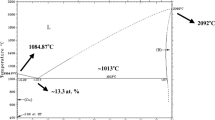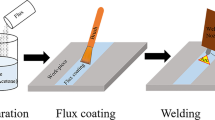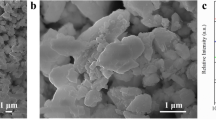Abstract
Monolithic aluminium 1000 alloy is used in overhead transmission conductors because of its light weight, high electrical conductivity and high passivation property. But its low strength is a very big challenge to this application. However, the strength can be improved by proper reinforcement in a way that will not compromise other properties. So, this work was focused on improving the strength and corrosion properties of Al alloy with carbon nanotubes (CNTs) using spark plasma sintering (SPS). The start-up powders were blended with tubular mixer and sintered with SPS technique. The densities, microhardness and corrosion characteristics of the sintered samples were determined accordingly. Results obtained showed that there was a homogeneous dispersion of CNTs in the Al matrix of all the samples except Al-8CNTs. Al-4CNTs gave the highest microhardness of 482.60 ± 12 MPa which represented 27% improvement in relation to monolithic Al alloy. Again, Al-4CNTs gave the least corrosion rate of 0.26723 mm/year in NaCl medium and 0.24188 mm/year in H2SO4 medium (46% and 47% improvements, respectively). These results indicate that Al-CNTs composite is a robust material for high transmission conductors.







Similar content being viewed by others
References
Yadav V, Harimkar SP (2011) Microstructure and properties of spark plasma sintered carbon nanotube reinforced aluminum matrix composites. Adv Eng Mater 13(12):1128–1134
Shi F (2012) Ceramic materials-progress in modern ceramics. InTech
Guillon O et al (2014) Field-assisted sintering technology/spark plasma sintering: mechanisms, materials, and technology developments. Adv Eng Mater 16(7):830–849
Choi H et al (2008) Reinforcement with carbon nanotubes in aluminum matrix composites. Scr Mater 59(3):360–363
Esawi AM et al (2009) Fabrication and properties of dispersed carbon nanotube–aluminum composites. Mater Sci Eng A 508(1-2):167–173
Saheb N, Mohammad K (2016) Microstructure and mechanical properties of spark plasma sintered Al2O3-SiC-CNTs hybrid nanocomposites. Ceram Int 42(10):12330–12340
Groza JR, Zavaliangos A (2000) Sintering activation by external electrical field. Mater Sci Eng A 287(2):171–177
Guo B et al (2017) Improving the mechanical properties of carbon nanotubes reinforced pure aluminum matrix composites by achieving non-equilibrium interface. Mater Des 120:56–65
Vidyasagar CS, Karunakar D (2018) Development of 2024 AA-Yttrium composites by spark plasma sintering. In: IOP Conference Series: Materials Science and Engineering. IOP Publishing
Long B et al (2010) Spark plasma sintering of mechanically alloyed in situ copper–niobium carbide composite. J Alloys Compd 505(2):510–515
Ullbrand JM et al (2010) Thermomechanical properties of copper–carbon nanofibre composites prepared by spark plasma sintering and hot pressing. Compos Sci Technol 70(16):2263–2268
Abbass MKMK, Anaee RA, Jabar MM (2016) Corrosion behavior of friction stir welded of similar and dissimilar Al2024-T3 and Al7075-T73 alloys. Int J Ser Eng Sci(ISSN: 2455-3328):1–15
Birol Y (2007) Response to thermal exposure of the mechanically alloyed Al–Ti/C powders. J Mater Sci 42(13):5123–5128
Alawar A, Bosze EJ, Nutt SR (2005) A composite core conductor for low sag at high temperatures. IEEE Trans Power Deliv 20(3):2193–2199
Fayomi O, Aigbodion V, Abdulwahab M (2016) Surface modification, strengthening effect and electrochemical comparative study of Zn-Al 2 O 3-CeO 3 and Zn-TiO 2-CeO 3 coating on mild steel. Int J Adv Manuf Technol 85(5-8):1419–1427
Thrash FR Jr (2014) Transmission conductors–A review of the design and selection criteria. Technical Support Article. Southwire Company. http://www.southwire.com/support/TransmissionConductoraReviewOfTheDesignandSelectionCriteria.htm. Accessed on 9/8/2014
Banerjee K (2014) Making the case for high temperature low sag (htls) overhead transmission line conductors. Arizona State University
Chen Y-P, Hong J (2010) Analysis on causes of blackout occurred in Brazilian power grid on Nov. 11, 2009 and lessons drawn from it to China southern power grid. Power Syst Technol:5
Chieh K et al (2009) The influences of powder mixing process on the quality of W-cu composites. J Trans Can Soc Mech Eng 33(3)
Ujah C, Popoola O, Aigbodion V (2019) Optimisation of spark plasma sintering parameters of Al-CNTs-Nb nano-composite using Taguchi Design of Experiment. Int J Adv Manuf Technol 100(5-8):1563–1573
Shongwe MB et al (2015) Effect of sintering temperature on the microstructure and mechanical properties of Fe–30% Ni alloys produced by spark plasma sintering. J Alloys Compd 649:824–832
Cahoon J, Broughton W, Kutzak A (1971) The determination of yield strength from hardness measurements. Metall Trans A 2(7):1979–1983
Ujah C, Popoola O, Aigbodion V (2018) Electrical conductivity, mechanical strength and corrosion characteristics of spark plasma sintered Al-Nb nanocomposite. Int J Adv Manuf Technol:1–8
Callister WD (2000) Fundamentals of materials science and engineering, vol 471660817. Wiley, London
Yamaoglu R, Olevsky EA (2016) Consolidation of Al-nanoSiC composites by spark plasma sintering. Int J Mater Mech Manuf 4(2):119–122
Gromov A et al (2019) Aluminum powders for energetics: properties and oxidation behavior. In: Nanomaterials in rocket propulsion systems. Elsevier, pp 151–173
Thomas S, Umasankar V (2018) Effect of MWCNT reinforcement on the precipitation-hardening behavior of AA2219. Int J Miner Metall Mater 25(1):53–61
Zhou M et al (2017) The effects of carbon nanotubes on the mechanical and wear properties of AZ31 alloy. Materials 10(12):1385
Murali S, Arvind TS, Raman KS, Murthy KS (1997) Fatigue properties of sand cast, stircast and extruded Al–7Si–0.3 Mg alloy with trace additions of Be and Mn. Mater Trans JIM 38(1):28–36
Lewandowski J, Liu C, Hunt W Jr (1989) Effects of matrix microstructure and particle distribution on fracture of an aluminum metal matrix composite. Mater Sci Eng A 107:241–255
Dutton S, Kelly D, Baker A (2004) Composite materials for aircraft structures. American Institute of Aeronautics and Astronautics
Starke E Jr, Rashed H (2017) Reference module in materials science and materials engineering, alloys: aluminum. Elsevier, pp 18–24
Skolianos S (1996) Mechanical behavior of cast SiCp-reinforced Al-4.5% Cu-1.5% Mg alloy. Mater Sci Eng A 210(1-2):76–82
Maiti A, Laha T (2018) Study of distribution of carbon nanotube in Al-CNT nanocomposite synthesized via spark-plasma sintering. In: IOP Conference Series: Materials Science and Engineering. IOP Publishing
Liao J-Z, Tan M-J, Sridhar I (2010) Spark plasma sintered multi-wall carbon nanotube reinforced aluminum matrix composites. Mater Des 31:S96–S100
Mansoor M, Shahid M (2016) Carbon nanotube-reinforced aluminum composite produced by induction melting. J Appl Res Technol 14(4):215–224
Laha T et al (2009) Tensile properties of carbon nanotube reinforced aluminum nanocomposite fabricated by plasma spray forming. Compos A: Appl Sci Manuf 40(5):589–594
Sarina B et al (2012) Wetting of pure aluminium on graphite, SiC and Al2O3 in aluminium filtration. Trans Nonferrous Metals Soc China 22(8):1930–1938
Sun F et al (2013) In situ synthesis of CNTs in Mg powder at low temperature for fabricating reinforced Mg composites. J Alloys Compd 551:496–501
Oladijo O et al (2016) Investigation the effect of porosity on corrosion resistance and hardness of wc-co coatings on metal substrates
Feng Q et al (2008) Investigation on the corrosion and oxidation resistance of Ni–Al2O3 nano-composite coatings prepared by sediment co-deposition. Surf Coat Technol 202(17):4137–4144
Ezuber H, El-Houd A, El-Shawesh F (2008) A study on the corrosion behavior of aluminum alloys in seawater. Mater Des 29(4):801–805
Acknowledgements
The authors would like to appreciate the financial supports of the following: CEEP, TUT, Pretoria and DHET. There is no conflict of interest in this work.
Author information
Authors and Affiliations
Corresponding author
Additional information
Publisher’s note
Springer Nature remains neutral with regard to jurisdictional claims in published maps and institutional affiliations.
Rights and permissions
About this article
Cite this article
Ujah, C.O., Popoola, A.P.I., Popoola, O.M. et al. Influence of CNTs addition on the mechanical, microstructural, and corrosion properties of Al alloy using spark plasma sintering technique. Int J Adv Manuf Technol 106, 2961–2969 (2020). https://doi.org/10.1007/s00170-019-04699-7
Received:
Accepted:
Published:
Issue Date:
DOI: https://doi.org/10.1007/s00170-019-04699-7




